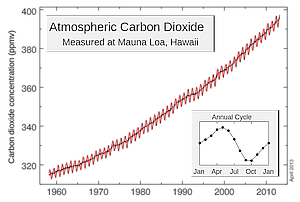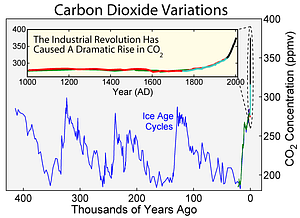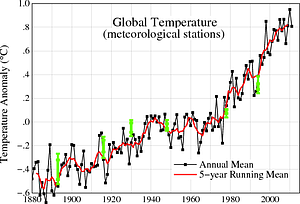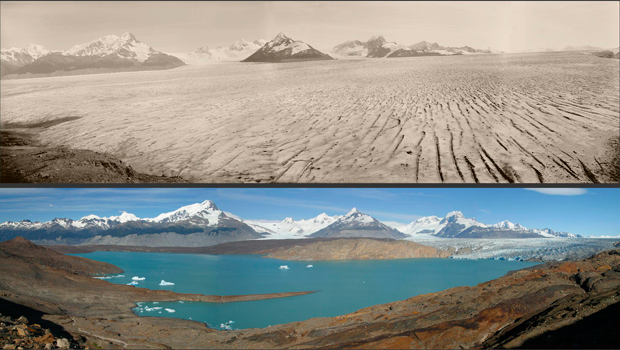2b.
Energy use and Climate change
The large scale combustion of fossil fuels, which have been going on since the beginning of industrialization around 1750, has led to massive emissions of carbon dioxide into the atmosphere. In addition, changes in land use, especially deforestation, have also contributed to large emissions of carbon dioxide. Estimations are that 1200 Giga tonnes of CO2 have entered the atmosphere in this way, almost all of it since 1900, and at a rate which is still increasing (about 32 Gt was emitted in 2008). Emitted carbon dioxide is partly dissolved in the world’s oceans. This reduces the content in the atmosphere, but also makes the ocean water more acidic. This is a threat to the world’s coral reefs and much marine biodiversity.
 Atmospheric carbon dioxide concentration has been carefully monitored since 1958 at a research station in Hawaii. It was 392 ppm (parts per million) in 2011. The concentration has increased from pre-industrial levels of about 280 ppm. The contribution from fossil fuel combustion can be estimated from the C14 content of atmospheric CO2, since there is no C14 in the fossil carbon. Through measurements of ice cores from the Antarctica and other data, we have estimations of carbon dioxide concentrations in the atmosphere since about 800 000 years. At no time during this period it was as high as it is today.
Atmospheric carbon dioxide concentration has been carefully monitored since 1958 at a research station in Hawaii. It was 392 ppm (parts per million) in 2011. The concentration has increased from pre-industrial levels of about 280 ppm. The contribution from fossil fuel combustion can be estimated from the C14 content of atmospheric CO2, since there is no C14 in the fossil carbon. Through measurements of ice cores from the Antarctica and other data, we have estimations of carbon dioxide concentrations in the atmosphere since about 800 000 years. At no time during this period it was as high as it is today.
Carbon dioxide is a Greenhouse Gas (GHG) and contributes to the so-called enhanced greenhouse effect of the atmosphere. Carbon dioxide absorbs heat and radiates it back, and thus increases the temperature of the planet. A greenhouse effect has already increased the planet temperature some 35 degrees due to already present GHGs (mostly water) that is why the effect caused by CO2 is called “enhanced”.
Other greenhouse gases which contribute to the enhanced greenhouse effect, include methane with 21 times higher radiative forcing than CO2, nitrous oxide N2O, and CFCs also called freons. Even if these three GHGs, also emitted from society, have a much larger effect, they are emitted in smaller volumes and have a shorter half-life in the atmosphere (they are broken down to CO2 and other components). Thus, CO2 with a very long half-life is the most serious one. If all GHGs are included according to their contributions recalculated as CO2 equivalents, we have today about 420 ppm CO2e (e stands for equivalent).
 The Climate of our Earth is of extreme importance to all life. It is studied by Climate sciences. The global temperature is the result of a balance between several factors. Basic is solar irradiation to the planet and heat radiation from the planet, but these simple factors are modified by several other parameters. Clouds increases temperature, snow and ice cover reflects sun (the albedo effect) and reduce temperature, while GHGs increases temperature. There is a variation of sun irradiation due to sun cycles and astronomic parameters (e.g. resulting in ice ages), a contribution from geothermal heat due to radioactive decay, and reduction of sunlight by volcanic ash after eruptions etc. Temperature distribution is critical for precipitation patterns, and the amount of water bound in glaciers decides ocean water sea levels.
The Climate of our Earth is of extreme importance to all life. It is studied by Climate sciences. The global temperature is the result of a balance between several factors. Basic is solar irradiation to the planet and heat radiation from the planet, but these simple factors are modified by several other parameters. Clouds increases temperature, snow and ice cover reflects sun (the albedo effect) and reduce temperature, while GHGs increases temperature. There is a variation of sun irradiation due to sun cycles and astronomic parameters (e.g. resulting in ice ages), a contribution from geothermal heat due to radioactive decay, and reduction of sunlight by volcanic ash after eruptions etc. Temperature distribution is critical for precipitation patterns, and the amount of water bound in glaciers decides ocean water sea levels.
An increase of the temperature of Earth due to the massive emissions of carbon dioxide has been predicted since long. We also observe that the planet is getting warmer. Compared to average temperature during the first half of 20th century, we have globally about 0.8 degrees warmer climate today. The 13 warmest years recorded have occurred during the last 15 years. This extra heat is not distributed equally on the planet. In general, the far north and south have a larger climate effect. The higher CO2 concentration in the atmosphere is expected to result in at least 2 degrees warming by mid-century, and up to 4 degrees warming by the end of the century. This will have dramatic consequences. (Compare the temperature difference between an ice age and the present, which is about 5 degrees.)
 Global warming has a number of effects, many of them already observed and some expected in the future. Extreme weather events will be stronger and come more often. This includes heat waves, tornados, hurricanes, storm, floods and draughts. In general, wet areas will be wetter and dry areas drier. The social, economic and environmental consequences of these are serious. Thus, the particularly hot year of 2003 in Europe had an additional 30 000 casualties due to heat. Agriculture will change, and harvests decrease in some areas (and increase in others). Hurricanes, storm, and floods in densely inhabited areas destroy infrastructure and property for immense values.
Global warming has a number of effects, many of them already observed and some expected in the future. Extreme weather events will be stronger and come more often. This includes heat waves, tornados, hurricanes, storm, floods and draughts. In general, wet areas will be wetter and dry areas drier. The social, economic and environmental consequences of these are serious. Thus, the particularly hot year of 2003 in Europe had an additional 30 000 casualties due to heat. Agriculture will change, and harvests decrease in some areas (and increase in others). Hurricanes, storm, and floods in densely inhabited areas destroy infrastructure and property for immense values.
Global warming can also be noted as reducing glaciers all over the planet, the melting of the Arctic winter ice, melting of the ice gap of Greenland and reduced glaciations of Antarctica. As all this ice become ocean water, the sea level is expected to increase by some 1–2 meters above present at the end of the 21st century. The Arctic summer ice may be gone by 2035, and the Canadian Arctic Ocean coast, the Northwest Passage, start to be used for ship transport.

There will also be large consequences for ecosystems, which all are very climate dependent. Thus, warmth-craving southern species (including insects being vectors for diseases) will move north while northern species (e.g. polar bears) become marginalized or disappear. Some of these effects are already painful. Crops have to be adapted to a different climate and in some areas' irrigation will be problematic.
Climate scientists build models of climate and climate change, assuming different scenarios for future developments. Although observing the ongoing changes do not need any models, we need models for understanding causes and predicting future changes. These models predict a very dramatic development if not emission of carbon dioxide and other GHGs ends. Especially they are concerned with so-called positive feed-backs, e.g. when ice cover reduces there will be less albedo (reflection) and this will increase temperature. Melting the Siberian permafrost releases large volumes of methane, which is a strong GHG. A number of such feedbacks have been identified. The models can to an extent predict changing temperatures and precipitation on the regional level. The Baltic Sea region is in a fairly good situation, although e.g. the environmental problems of the Baltic Sea are likely to get worse.
The public debate on global warming has been intense for many years, and those denying what have been described here have had a large exposure. These climate deniers either deny that there is a global warming at all, or that this warming is due to what we did in society (especially combustion of fossil fuels) and argue that there are other reasons, such as increased solar radiation. These opinions are typical for non-scientists, at least non-climatologists. Among the experts, e.g. in the research literature, there are only very few among thousands who question the established picture, even if in some cases there may be good reasons to do so. For examples, data on historical temperatures and carbon dioxide concentrations are all indirect and can be interpreted differently, but the picture described above has support from a large majority. Among non-scientists, it appears that especially those who are facing and not prepared to accept the very threatening consequences of the global warming take denial as a way out.
Obviously, the costs for the damages caused by extreme weather events are tremendous. From this point of view, it would be better to invest in mitigation (reducing climate change) than paying for the consequences. The respected World Bank economists Sir Nicholas Stern after an extensive expert study reported to the British government on the costs of climate change and the costs of mitigation and estimated that 1% of the GDP should be used for mitigation measures, rather than waiting for higher costs for impacts later on. The world has not followed his advice.
Materials for session 2b
Basic level
- Read the introductory part of the Intergovernmental Panel for Climate Change, IPCC, 4th assessment report. See also the Sixth Assessment Report.
- European Environmental Agencies report on global temperature changes.
- The Climate Change Collection in Encyclopedia of the Earth.
- Wikipedia: List of CO2 emissions by country.
- How Do Carbon Dioxide Concentrations in the Atmosphere Affect Global Climate? Part I, Part II, Part III (YouTube films)
- Watch 131 Years of Global Warming in 26 Seconds (Climate Central Video), see also Global Change 1850 - 2020 (YouTube film)
Medium level (widening)
- Read on Climate modelling at the website of National Oceanic and Atmospheric Administration (NOAA).
- Read on the effects of Climate Change (IPCC, 5th AR).
- Look at how science is responding to the arguments of the so-called sceptics.
- Look at how sceptics are responding to the arguments of science.
Advanced level (deepening)
- The Stern Report on the economic costs of climate change.
References
Intergovernmental Panel on Climate Change 2007. Climate Change, 2007 - The Physical Science Basis: Working Group I Contribution to the Fourth Assessment Report of the IPCC.
Intergovernmental Panel on Climate Change 2007. Climate Change 2007 - Impacts, Adaptation and Vulnerability: Working Group II contribution to the Fourth Assessment Report of the IPCC
Intergovernmental Panel on Climate Change 2007. Climate Change 2007 - Mitigation of Climate Change: Working Group III contribution to the Fourth Assessment Report of the IPCC.
Stern, N. 2007. The Economics of Climate Change: The Stern Review.
